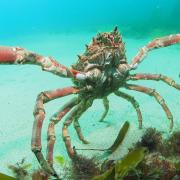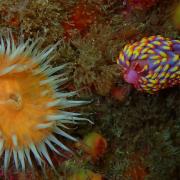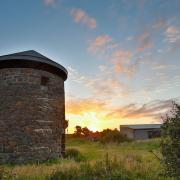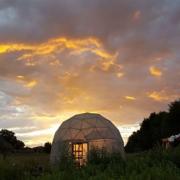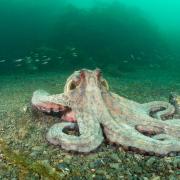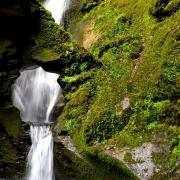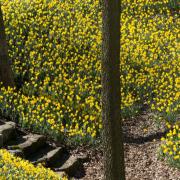There are a number of incredible animals to spot whilst enjoying the gorgeous Cornish landscape.
New research from Lovat Parks reveals the powerful benefits to mental health from immersion in nature. And, to encourage the nation to engage with wildlife and enjoy these benefits themselves this summer, the holiday parks company has partnered with conservationist and TV presenter Megan McCubbin to create the ‘Big 5’ wildlife wonders that can be spotted on our very own isles this summer.
The report, which for the first time brings together findings from 19 academic studies, was commissioned by Lovat Parks in partnership with Professor Andrea Mechelli – researcher specialising in the environment’s impact on mental health at King’s College London – to provide new insight into the health benefits of getting back to nature and immersing in wild spaces.

Whilst the physical health benefits of interacting with nature have been widely celebrated, the improvements to mental wellbeing have been less well documented, making today’s report all the more exciting. Amongst the findings, Professor Mechelli’s report reveals.
- Higher cognitive performance and emotional wellbeing in children who spend more time in green spaces
- 20% reduced risk of developing depression in those who spend significant amounts of time in natural environments
- 28% lower likelihood of feeling lonely when in nature
- A significant reduction in risk of developing depression and generalised anxiety disorder amongst those who spend time in nature
- 81% improvement in mental wellbeing when in the presence of trees
Although benefits can be reaped from just a small dose of greenery, environments which combine a diverse range of natural features such as trees, grass, wildlife and waterways are likely to lead to even greater, lasting benefits.
Inspired by these findings, Lovat Parks is encouraging Brits to connect with their wild side and head out on their very own UK ‘Big 5’ safari – no long flights or passports needed!

The ‘Big 5’ – a collection of the UK’s wildest animals that can be encountered throughout the summer – incorporates species found across the country; most can even be spotted in and around Lovat Parks’ luxury holiday sites:
- Blue sharks: Despite their popular image, these top predators aren’t restricted to the tropics, taking up residence in UK waters during the summer months.
- Puffins: These exotic-looking, colourful seabirds are perhaps a surprising UK local but there are around 580,000 pairs that call our shores home and can be found from Cornwall to Scotland.
- Grey seals: The biggest land breeding mammal in the UK, 40% of the world’s population of grey seals live in our coastal waters and can be found from Cornwall to Norfolk.
- Otters: Driven to the brink of extinction until the 1970s these charismatic carnivores can now be found up and down river banks across the country following an improvement in water quality.
- Elephant... hawk moths: As alluring as their trunked name sakes of the African ‘Big 5’, these bright pink moths are on the wing between May-June and as caterpillars they mimic snakes to ward off predator.

Commenting on the ‘Big 5’, Megan said:
“It can be easy to overlook incredible things when they’re on your doorstep but the beauty and variety of nature we have here in the UK really should not be missed.
“It may come as a surprise to people that some of the wildlife on the ‘Big 5’ list I’ve created with Lovat Parks can be found in the UK; but places like Cornwall, Norfolk and the New Forest are rich with diverse wildlife.
“Today’s report clearly shows the benefits that connecting with the natural world can have to our physical and mental wellbeing, so I would encourage everyone to get away to the great British countryside for a break this summer if they can.”
You can find more details about where to see the Big 5 on the Lovat Parks website here.

More Wildlife in Cornwall
Park Leisure, who have three locations in Cornwall alone, have also recommended local wildlife you can spot whilst visiting our county:
Beavers: once-extinct in Britain, Beavers made a return to Cornwall in 2017 and can now be seen making busy work of building dams in Woodland Valley Farm near Ladlock which is the home of the Cornwall Beaver Project.
Pine Marten: Spotted in Cornwall for the first time in over 100 years, these small nocturnal creatures' habitat is usually woodlands where they are often found in small holes in trees or old birds' nests. Usually found in the North of the UK a recent sighting on a night vision camera in Cornwall has excited experts and if you’re lucky enough, you might see one too.
Basking Shark: The second largest fish in the world, these incredible underwater creatures migrate to Cornish seas between April and October as the waters become warmer.
Oystercatchers: This large black and white bird can be found along the coasts of Cornwall all year around. They graze on the beaches waiting for mussels and cockles to wash up on the shore. A noticeable feature of these birds is their large orange beak which helps them dig around for seafood delicacies or when inland, worms.
Swallows: After spending the winter seasons in South Africa, the swallows fly back towards the UK with Cornwall possibly being one of the first places they land. Places such as Marazion Marsh are perfect for spotting Swallows.

Want more from Cornwall Life?
Check out:
- Cornish cycle route named best in the UK
- Cornwall's most amazing lighthouses
- Cornwall wins National Lottery Fund to save heritage sites
You can also subscribe to Cornwall Life Magazine for more amazing and exclusive content here, or sign up for our newsletter here.











